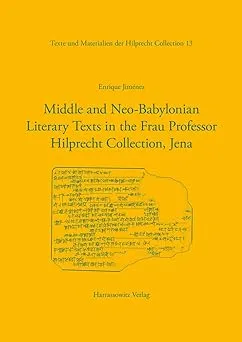Enrique Jimenez, "Middle and Neo-Babylonian Literary Texts in the Frau Professor Hilprecht Collection, Jena"
English | 2022 | ISBN: 3447118814 | PDF | pages: 404 | 57.0 mb
English | 2022 | ISBN: 3447118814 | PDF | pages: 404 | 57.0 mb
The book contains first editions of thirty-three cuneiform tablets from the Frau Professor Hilprecht Collection, dating to the second half of the second millennium and the first millennium BCE, as well as duplicates and parallels from other museums. The majority of the edited tablets stem from the city of Nippur, but the book also includes manuscripts from Assur and Babylon. The tablets comprise literary, magic, and divinatory texts, as well as fifteen Middle and Neo-Babylonian school manuscripts with excerpts from various compositions. The literary texts include a large prayer invoking blessings of Nippur gods upon the king, known in other cities as well; a wisdom monologue, and a manuscript of The Exaltation of Istar. The magic section includes Middle Babylonian versions of anti-witchcraft incantations previously known in the first millennium, as well as exorcistic spells, and formulas to be recited upon the consecration of Nippur priests. Extispicy, hemerologies, and physiognomy are among the divinatory texts edited. The school tablets contain excerpts from several texts previously unknown to have survived into the respective periods, such as a Middle Babylonian version of Tamarisk and Palm and a first-millennium version of the wisdom text Hearken to the Advice. The introduction of the book contains an overview of Nippur history, as well as a discussion of the provenance of the tablets and their social and school contexts. The city of Nippur, whose scholarly production circulated widely in Antiquity, is strangely bereft of scholarly manuscripts, a fact that the book seeks to explain.



